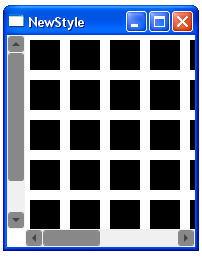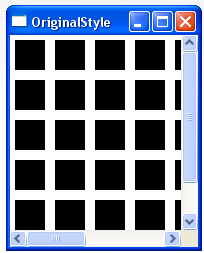A while ago, I was looking at the Infragistics WPF showcase, Tangerine and I was quite jealous about the scrollbars that they managed to use. I mean styling a Button is one thing, but the ScrollBar is made of lots of nasty different control parts, (Part_XXX elements). Incidentally, I wrote an article about Part_XXX elements in a WPF article over at CodeProject right here if you are interested.
Anyways, to cut a long story short, I decided to try and have a go at Styling a bigger control such as ScrollViewer. And guess what I managed to do it. Hooray!
This is what it looks like:
 |  |
| My Styled ScrollViewer
| Original ScrollViewer
|
This blog entry outlines the steps I went through.
Step 1
Look up and copy the original ScrollViewer and ScrollBar Templates from MSDN, for example:
Then I pasted that code from MSDN into a Resources file in a WPF window.
Step 2
I examined the control parts required for the full ScrollViewer/Scrollbar controls. This was fairly ok actually as the MSDN default Styles and pretty easy to follow.
From looking at the default styles, it became clear that I needed to look at the following Style/Templates if I wished to re-style a ScrollViewer, as all of these were used in the default Style for the ScrollViewer somewhere.
Step 3
I then decided which parts I want to swap out. I chose to swap out and proceeded to hack the default Style/Templates to achieve the look I was after.
Anyway, the results ScrollViewer looks like the following image:
RepeatButtonThumbScrollBarScrollViewer
When you consider the following image, you can see why these are the Style/Templates that need to be altered.

So basically after that, it's just a question of cutting code. So without further ado, here is the code:
<Window
xmlns="http://schemas.microsoft.com/winfx/2006/xaml/presentation"
xmlns:x="http://schemas.microsoft.com/winfx/2006/xaml"
xmlns:mc="http://schemas.openxmlformats.org/markup-compatibility/2006″
x:Class="ScrollViewerTemplate.Window1″
x:Name="Window"
Title="Window1″
Width="200″ Height="200″>
<Window.Resources>
<!– All the following is required to Re-Style the ScrollViewer, see
http://msdn2.microsoft.com/en-us/library/aa970847(VS.85).aspx
http://msdn2.microsoft.com/en-us/library/ms742173(VS.85).aspx
for the default Styles that the ScrollViewer has out of the box
–>
<!– Brushes used in Styling of ScrollViewer –>
<SolidColorBrush x:Key="StandardBorderBrush" Color="#888″ />
<SolidColorBrush x:Key="StandardBackgroundBrush" Color="#FFF" />
<SolidColorBrush x:Key="HoverBorderBrush" Color="#DDD" />
<SolidColorBrush x:Key="SelectedBackgroundBrush" Color="Gray" />
<SolidColorBrush x:Key="SelectedForegroundBrush" Color="White" />
<SolidColorBrush x:Key="DisabledForegroundBrush" Color="#888″ />
<SolidColorBrush x:Key="NormalBrush" Color="#888″ />
<SolidColorBrush x:Key="NormalBorderBrush" Color="#888″ />
<SolidColorBrush x:Key="HorizontalNormalBrush" Color="#888″ />
<SolidColorBrush x:Key="HorizontalNormalBorderBrush" Color="#888″ />
<LinearGradientBrush x:Key="ListBoxBackgroundBrush"
StartPoint="0,0″ EndPoint="1,0.001″>
<GradientBrush.GradientStops>
<GradientStopCollection>
<GradientStop Color="White" Offset="0.0″ />
<GradientStop Color="White" Offset="0.6″ />
<GradientStop Color="#DDDDDD" Offset="1.2″/>
</GradientStopCollection>
</GradientBrush.GradientStops>
</LinearGradientBrush>
<LinearGradientBrush x:Key="StandardBrush"
StartPoint="0,0″ EndPoint="0,1″>
<GradientBrush.GradientStops>
<GradientStopCollection>
<GradientStop Color="#FFF" Offset="0.0″/>
<GradientStop Color="#CCC" Offset="1.0″/>
</GradientStopCollection>
</GradientBrush.GradientStops>
</LinearGradientBrush>
<SolidColorBrush x:Key="GlyphBrush" Color="#444″ />
<LinearGradientBrush x:Key="PressedBrush"
StartPoint="0,0″ EndPoint="0,1″>
<GradientBrush.GradientStops>
<GradientStopCollection>
<GradientStop Color="#BBB" Offset="0.0″/>
<GradientStop Color="#EEE" Offset="0.1″/>
<GradientStop Color="#EEE" Offset="0.9″/>
<GradientStop Color="#FFF" Offset="1.0″/>
</GradientStopCollection>
</GradientBrush.GradientStops>
</LinearGradientBrush>
<!– SrollViewer ScrollBar Repeat Buttons (at each end) –>
<Style x:Key="ScrollBarLineButton" TargetType="{x:Type RepeatButton}">
<Setter Property="SnapsToDevicePixels" Value="True"/>
<Setter Property="OverridesDefaultStyle" Value="true"/>
<Setter Property="Focusable" Value="false"/>
<Setter Property="Template">
<Setter.Value>
<ControlTemplate TargetType="{x:Type RepeatButton}">
<Border
Name="Border"
Margin="1″
CornerRadius="2″
Background="{StaticResource NormalBrush}"
BorderBrush="{StaticResource NormalBorderBrush}"
BorderThickness="1″>
<Path
HorizontalAlignment="Center"
VerticalAlignment="Center"
Fill="{StaticResource GlyphBrush}"
Data="{Binding Path=Content,
RelativeSource={RelativeSource TemplatedParent}}" />
</Border>
<ControlTemplate.Triggers>
<Trigger Property="IsPressed" Value="true">
<Setter TargetName="Border" Property="Background"
Value="{StaticResource PressedBrush}" />
</Trigger>
<Trigger Property="IsEnabled" Value="false">
<Setter Property="Foreground"
Value="{StaticResource DisabledForegroundBrush}"/>
</Trigger>
</ControlTemplate.Triggers>
</ControlTemplate>
</Setter.Value>
</Setter>
</Style>
<!– SrollViewer ScrollBar Repeat Buttons (The part in the middle,
not the thumb the long area between the buttons ) –>
<Style x:Key="ScrollBarPageButton" TargetType="{x:Type RepeatButton}">
<Setter Property="SnapsToDevicePixels" Value="True"/>
<Setter Property="OverridesDefaultStyle" Value="true"/>
<Setter Property="IsTabStop" Value="false"/>
<Setter Property="Focusable" Value="false"/>
<Setter Property="Template">
<Setter.Value>
<ControlTemplate TargetType="{x:Type RepeatButton}">
<Border Background="Transparent" />
</ControlTemplate>
</Setter.Value>
</Setter>
</Style>
<!– ScrollViewer ScrollBar Thumb, that part that can be dragged
up/down or left/right Buttons –>
<Style x:Key="ScrollBarThumb" TargetType="{x:Type Thumb}">
<Setter Property="SnapsToDevicePixels" Value="True"/>
<Setter Property="OverridesDefaultStyle" Value="true"/>
<Setter Property="IsTabStop" Value="false"/>
<Setter Property="Focusable" Value="false"/>
<Setter Property="Template">
<Setter.Value>
<ControlTemplate TargetType="{x:Type Thumb}">
<Border
CornerRadius="2″
Background="{TemplateBinding Background}"
BorderBrush="{TemplateBinding BorderBrush}"
BorderThickness="1″ />
</ControlTemplate>
</Setter.Value>
</Setter>
</Style>
<ControlTemplate x:Key="VerticalScrollBar"
TargetType="{x:Type ScrollBar}">
<Grid >
<Grid.RowDefinitions>
<RowDefinition MaxHeight="18″/>
<RowDefinition Height="0.00001*"/>
<RowDefinition MaxHeight="18″/>
</Grid.RowDefinitions>
<Border
Grid.RowSpan="3″
CornerRadius="2″
Background="#F0F0F0″ />
<RepeatButton
Grid.Row="0″
Style="{StaticResource ScrollBarLineButton}"
Height="18″
Command="ScrollBar.LineUpCommand"
Content="M 0 4 L 8 4 L 4 0 Z" />
<Track
Name="PART_Track"
Grid.Row="1″
IsDirectionReversed="true">
<Track.DecreaseRepeatButton>
<RepeatButton
Style="{StaticResource ScrollBarPageButton}"
Command="ScrollBar.PageUpCommand" />
</Track.DecreaseRepeatButton>
<Track.Thumb>
<Thumb
Style="{StaticResource ScrollBarThumb}"
Margin="1,0,1,0″
Background="{StaticResource HorizontalNormalBrush}"
BorderBrush="{StaticResource HorizontalNormalBorderBrush}" />
</Track.Thumb>
<Track.IncreaseRepeatButton>
<RepeatButton
Style="{StaticResource ScrollBarPageButton}"
Command="ScrollBar.PageDownCommand" />
</Track.IncreaseRepeatButton>
</Track>
<RepeatButton
Grid.Row="3″
Style="{StaticResource ScrollBarLineButton}"
Height="18″
Command="ScrollBar.LineDownCommand"
Content="M 0 0 L 4 4 L 8 0 Z"/>
</Grid>
</ControlTemplate>
<!– HorizontalScrollBar Template using the previously created Templates –>
<ControlTemplate x:Key="HorizontalScrollBar"
TargetType="{x:Type ScrollBar}">
<Grid >
<Grid.ColumnDefinitions>
<ColumnDefinition MaxWidth="18″/>
<ColumnDefinition Width="0.00001*"/>
<ColumnDefinition MaxWidth="18″/>
</Grid.ColumnDefinitions>
<Border
Grid.ColumnSpan="3″
CornerRadius="2″
Background="#F0F0F0″ />
<RepeatButton
Grid.Column="0″
Style="{StaticResource ScrollBarLineButton}"
Width="18″
Command="ScrollBar.LineLeftCommand"
Content="M 4 0 L 4 8 L 0 4 Z" />
<Track
Name="PART_Track"
Grid.Column="1″
IsDirectionReversed="False">
<Track.DecreaseRepeatButton>
<RepeatButton
Style="{StaticResource ScrollBarPageButton}"
Command="ScrollBar.PageLeftCommand" />
</Track.DecreaseRepeatButton>
<Track.Thumb>
<Thumb
Style="{StaticResource ScrollBarThumb}"
Margin="0,1,0,1″
Background="{StaticResource NormalBrush}"
BorderBrush="{StaticResource NormalBorderBrush}" />
</Track.Thumb>
<Track.IncreaseRepeatButton>
<RepeatButton
Style="{StaticResource ScrollBarPageButton}"
Command="ScrollBar.PageRightCommand" />
</Track.IncreaseRepeatButton>
</Track>
<RepeatButton
Grid.Column="3″
Style="{StaticResource ScrollBarLineButton}"
Width="18″
Command="ScrollBar.LineRightCommand"
Content="M 0 0 L 4 4 L 0 8 Z"/>
</Grid>
</ControlTemplate>
<!– Style for overall ScrollBar –>
<Style x:Key="{x:Type ScrollBar}" TargetType="{x:Type ScrollBar}">
<Setter Property="SnapsToDevicePixels" Value="True"/>
<Setter Property="OverridesDefaultStyle" Value="true"/>
<Style.Triggers>
<Trigger Property="Orientation" Value="Horizontal">
<Setter Property="Width" Value="Auto"/>
<Setter Property="Height" Value="18″ />
<Setter Property="Template"
Value="{StaticResource HorizontalScrollBar}" />
</Trigger>
<Trigger Property="Orientation" Value="Vertical">
<Setter Property="Width" Value="18″/>
<Setter Property="Height" Value="Auto" />
<Setter Property="Template"
Value="{StaticResource VerticalScrollBar}" />
</Trigger>
</Style.Triggers>
</Style>
<!– Style for overall ScrollViewer –>
<Style x:Key="FavsScrollViewer" TargetType="{x:Type ScrollViewer}">
<Setter Property="OverridesDefaultStyle" Value="True"/>
<Setter Property="Template">
<Setter.Value>
<ControlTemplate TargetType="{x:Type ScrollViewer}">
<Grid>
<Grid.ColumnDefinitions>
<ColumnDefinition Width="Auto"/>
<ColumnDefinition/>
</Grid.ColumnDefinitions>
<Grid.RowDefinitions>
<RowDefinition/>
<RowDefinition Height="Auto"/>
</Grid.RowDefinitions>
<ScrollContentPresenter Grid.Column="1″/>
<ScrollBar Name="PART_VerticalScrollBar"
Value="{TemplateBinding VerticalOffset}"
Maximum="{TemplateBinding ScrollableHeight}"
ViewportSize="{TemplateBinding ViewportHeight}"
Visibility="{TemplateBinding ComputedVerticalScrollBarVisibility}"/>
<ScrollBar Name="PART_HorizontalScrollBar"
Orientation="Horizontal"
Grid.Row="1″
Grid.Column="1″
Value="{TemplateBinding HorizontalOffset}"
Maximum="{TemplateBinding ScrollableWidth}"
ViewportSize="{TemplateBinding ViewportWidth}"
Visibility="{TemplateBinding ComputedHorizontalScrollBarVisibility}"/>
</Grid>
</ControlTemplate>
</Setter.Value>
</Setter>
</Style>
</Window.Resources>
<Grid x:Name="LayoutRoot">
<ScrollViewer RenderTransformOrigin="0.5,0.5″ HorizontalAlignment="Stretch"
Margin="0,0,0,0″
Width="Auto" HorizontalScrollBarVisibility="Visible"
Style="{StaticResource FavsScrollViewer}">
</ScrollViewer>
</Grid>
</Window>
And if you want to try this for yourself, here is a VS 2008 demo project.
 General
General  News
News  Suggestion
Suggestion  Question
Question  Bug
Bug  Answer
Answer  Joke
Joke  Praise
Praise  Rant
Rant  Admin
Admin 






